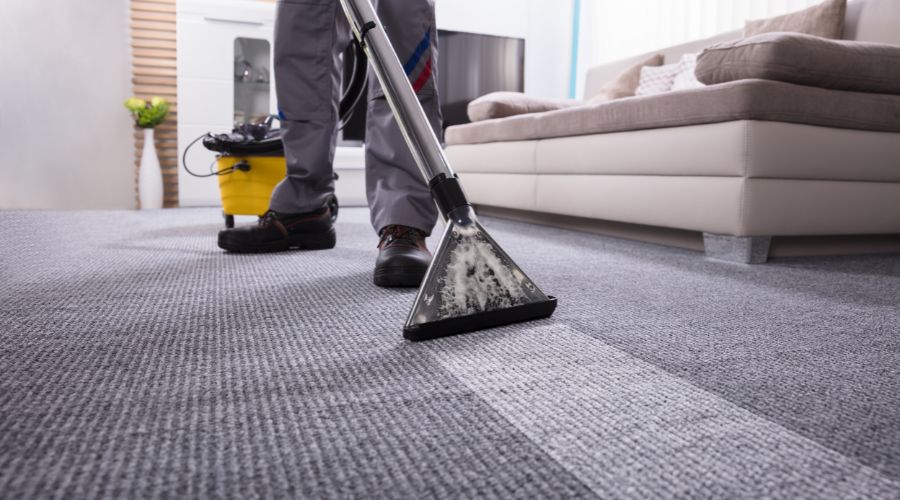Living with allergies can be challenging, especially when your home becomes a breeding ground for allergens, with carpets being a major culprit. This blog post emphasizes the importance of regular carpet cleaning for allergy sufferers. It explores how carpets harbor microscopic particles that trigger allergic reactions and explains the impact of allergen accumulation on health. The post discusses effective carpet cleaning techniques, such as vacuuming, deep cleaning, and allergen-reducing treatments, to minimize allergens and improve air quality. It also provides additional tips for allergy management, including dusting, air purification, humidity control, and pet care.
By implementing these strategies, allergy sufferers can create a clean and healthy indoor environment that reduces allergen exposure and enhances overall well-being. The blog post aims to empower readers with the knowledge and practical solutions to combat allergens in their homes, allowing them to enjoy a comfortable and allergy-free living space.
1. Understanding Allergens and Their Impact on Health

Dust mites and other allergens are microscopic animals that prefer warm, humid settings to survive. These tiny bugs feed on dead skin cells, and the allergens in their excrement are strong enough to cause allergic reactions. Another frequent allergy, pet dander, is made up of small skin fragments and proteins that animals like cats and dogs shed. Pollen is a reproductive byproduct of plants that easily makes its way into our houses, where it settles in carpets and irritates people who are sensitive to it.
For people who suffer from allergies, mold spores, which are invisible to the unaided eye, are a major worry. They can grow on carpets if moisture is present, and they do well in humid environments. Inhaling mold spores can aggravate allergy symptoms and lead to respiratory problems. Mold emits spores into the air. In addition, some people may experience allergic reactions to insect faeces, such as cockroach faeces, and these traces can build up in carpets.
A constant concern to allergy sufferers comes from the buildup of these allergens in carpets. These allergens can become airborne when individuals walk on carpets or hoover them, where they can then be easily breathed into the respiratory system. People with allergies have immune systems that overreact to these compounds, which sets off a chain reaction of symptoms meant to rid the body of the perceived threat.
The symptoms, which can be minor to severe for many allergy patients, can have a considerable negative influence on their quality of life. Shortness of breath, coughing, wheezing, itchy and watery eyes, sneezing fits, nasal congestion, and shortness of breath are just a few of the painful symptoms. Finding relief from the symptoms of carpet allergen exposure can be difficult because the cycle of exposure and symptoms persists without proper cleaning and maintenance.
The importance of addressing carpet cleaning for allergy sufferers is made clear by recognizing the connection between allergens and allergies. We may lessen allergen buildup, lower exposure, and lessen the burden of allergy reactions by concentrating on efficient carpet cleaning processes.
2. The Role of Carpets in Allergen Accumulation

Due to the nature of their construction, carpets are a prime location for the collection of allergens. Dust mites, pet dander, pollen, and mold spores can all settle and become deeply lodged into carpet fibers because of their fibrous structure. Through numerous channels, such as foot traffic, open windows, or even air circulation within the house, these particles can easily make their way into the carpet.
Regular motions like walking or even vacuuming might disturb these allergens, making them airborne and simple for allergy sufferers to breathe in. Walking across carpeted flooring can cause a cloud of allergens to be released, which can trigger an allergic reaction right away. Since the allergens are constantly present and challenging to avoid due to this ongoing exposure, carpets pose a serious risk for those who have allergies.
As a result of trapping moisture, carpets can also contribute to the development of mold and mildew by producing an environment that is damp. This presents a particular issue in places with high humidity levels or where spills and moisture accidents happen. Mold spores can easily penetrate carpets, and when moisture is present, this can result in mold growth within the carpet fibers. The effects of other allergens found in the carpet can be exacerbated by the release of mold spores into the air, which can cause allergic reactions and respiratory distress in sensitive people.
In addition to trapping allergies, carpets’ fibrous texture makes it difficult to effectively remove them. Regular vacuuming can be somewhat helpful, but it might not be able to remove all of the allergens that are deeply buried. As a result, the allergens continue to exist in the carpet and provide a risk to people who suffer from allergies. While carpets might cause issues for allergy sufferers, it’s crucial to remember that they can also serve as filters, capturing allergens and stopping them from flowing freely in the air. However, if carpets aren’t properly cleaned and maintained, they can collect allergens and exacerbate allergic symptoms.
3. Effective Carpet Cleaning Techniques To Remove Allergens

Vacuuming: In order to effectively remove allergens from carpets, regular, thorough vacuuming with a vacuum cleaner with a HEPA filter is essential. To successfully trap allergen particles, concentrate on high-traffic areas, corners, and edges. Set up a regular vacuuming plan, and for thorough allergen elimination, consider professional carpet cleaning from time to time. The vacuum cleaner performs best when properly maintained, which includes cleaning or replacing filters and emptying the dust container. Together, these actions improve the overall air quality in the home and provide allergy sufferers with a cleaner, healthier indoor environment.
Deep Cleaning: For allergy sufferers to maintain a clean and allergen-free indoor environment, regular deep cleaning of carpets is necessary. Hot water and detergent are used in steam cleaning, sometimes referred to as hot water extraction, to effectively remove dirt, allergens, and stains from carpets. Expertise, specialized tools, and thorough extraction are offered by professional steam cleaning services to provide the best cleaning outcomes and a considerable reduction in allergy levels. Steam cleaning is an essential practice for allergy sufferers because it removes hidden allergens and promotes a better indoor environment. Steam cleaning appointments should be made every 12 to 18 months, or more frequently in homes with children who have severe allergies or asthma.
Allergen-Reducing Treatments: To help neutralise and lower allergy levels, allergen-reducing treatments, such as sprays or powders, can be applied to carpets. It’s critical to select solutions that are safe for both the environment and allergy sufferers. These treatments should be used as a stand-alone treatment or after vacuuming and before steam cleaning because they act by denaturing allergenic proteins. Look for choices that have been created especially to reduce allergens in carpets and are fragrance- and hypoallergenic. Although these procedures may be helpful, they shouldn’t take the place of routine vacuuming and expert cleaning. A further layer of allergen management can be achieved by incorporating allergen-reducing treatments in addition to the cleaning regimen. Before using the treatment on the entire carpeted area, perform a patch test. You can further reduce allergen exposure and improve the interior environment for allergy patients by adopting these remedies. Also, ensure to get pest control done after some interval to maintain safety and health.
Regular Maintenance: To reduce the buildup of allergens in carpets, preventive actions must be taken. Use doormats at the doorways, promote shoe removal, and keep your home tidy and clutter-free. To lower allergy levels, regular cleaning, dusting, and pet care are essential. To increase the quality of the air, think about employing air purifiers with HEPA filters. You may make your home cleaner and healthier for allergy sufferers by combining these steps with routine vacuuming and expert cleaning.
4. Additional Tips for Allergy Management

There are further steps allergy sufferers can take in addition to routine carpet cleaning to effectively manage their allergies. These consist of:
Dusting and Cleaning: To reduce allergen exposure in their homes, allergy sufferers must regularly dust and clean. Dust all surfaces, including furniture, shelves, and countertops, using allergen-reducing cleaning supplies and moist cloths. Consider using hypoallergenic pillows and mattress covers, and wash your bedding in hot water to get rid of dust mites and other allergies. Use a vacuum cleaner with a HEPA filter to clean blinds, curtains, and upholstery to get rid of dust, pet dander, and other allergies. By lowering the number of allergens in houses, these procedures will aid in creating a cleaner and healthier living environment for allergy patients.
Air Purification: Use air purifiers with HEPA filters to reduce allergy exposure and further enhance indoor air quality. Dust mites, pollen, cat dander, and mold spores are just a few examples of airborne allergens that these filters are made to trap and capture. Place the air purifiers in rooms or spaces that are frequently utilized by allergy sufferers. To guarantee optimum operation, it’s critical to routinely clean and change the filters in accordance with the manufacturer’s instructions. You can greatly reduce the number of allergens in the air in your house and provide an environment that is better for allergy sufferers by installing air purifiers.
Humidity Control: For your home to have fewer allergic reaction-related concerns, proper humidity control is essential. High humidity can encourage the growth of mold, which can exacerbate allergies. Use dehumidifiers in wet spaces like bathrooms or basements to maintain ideal humidity levels. By opening windows or employing exhaust fans in parts of your home that are prone to moisture, you can ensure optimum ventilation throughout. To stop the growth of mold and mildew, immediately clean up and dry any spills or water leaks. You may make your home’s air quality better overall by correctly managing humidity and avoiding moisture buildup, which will make it less conducive for allergens like mold to thrive.
Pet Care: Create a regular grooming program for your pets to remove loose fur and lessen shedding in order to reduce shedding and dander production. To prevent the development of allergens, keep pets away from carpeted areas and cover furniture they frequently use with allergen-resistant covers. To get rid of fur, dander, and allergens from pet bedding, wash it frequently. You should also hoover your carpets and furniture periodically, paying special attention to the areas where your pet spends the most time. You can make your home cleaner and more allergy-friendly for you and your pets this summer by following these instructions.
Professional Allergen Testing: Consider hiring experts to perform allergen testing if your allergies continue despite your efforts to decrease allergens in your house. They can pinpoint certain allergens by examining air and surface samples, and they can offer individualised suggestions for raising indoor air quality and lowering allergies. They can also recommend extra steps that are unique to the allergens found, such as utilizing specialized cleaning supplies or covering beds with allergen-resistant covers. Allergy symptoms can be reduced and a healthier living environment can be produced by putting these efforts together with routine cleaning and proper indoor hygiene.
Conclusion
For people with allergies, keeping their surroundings clean and free of allergens is essential. Cleaning the carpet is a crucial step in this procedure and can greatly reduce the collection of allergens. You can make your home healthier by regularly vacuuming, deep cleaning, and other allergen-reduction techniques. To treat allergies effectively, it’s crucial to address additional potential allergen sources and take a comprehensive strategy. The health of allergy patients and their families can be enhanced by integrating effective carpet cleaning techniques with general home cleaning techniques. Accept the advantages of routine carpet cleaning and delight in a healthier living space that reduces allergy symptoms and improves general well-being.

